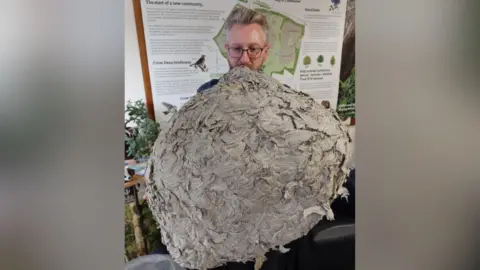Giant nest causing a buzz about wasps
 The Wildlife Trust for Beds, Cambs & Northants
The Wildlife Trust for Beds, Cambs & NorthantsA wildlife trust hopes a giant wasp nest found in a house could help people better understand the insect.
The impressive structure, measuring an estimated 75cm (30in) across, was donated to the Wildlife Trust for Bedfordshire, Cambridgeshire and Northamptonshire by a pest controller, who was called to remove it from an attic.
Now situated in the entrance to the trust's office in Cambourne, Cambridgeshire, the nest has gained attention and also highlighted that wasps are skilled architects.
Community conservation officer Iain Webb said it was a "great educational tool" and created an opportunity to talk about their value in the wider environment.
How are nests made?
The only wasps that survive winter are pregnant females, or queens.
In spring, if they successfully emerge from hibernation, they will find somewhere suitable, dry, warm and airy to start the nest where she will lay her eggs.
"In the midsummer, you'll see, or you might even hear, a scraping sound on wooden fencing or furniture in your garden," Mr Webb said.
"If you focus on the sound, you'll see it's a little wasp just scraping the top surface of wood."
The wasp will go back to its nest with a small pellet of wood in its mouth and create a sort of laminate of the wood pulp, a bit like paper, that dries and solidifies.
This process is repeated until the nest is ready for the larvae to develop.
"The detail and the different sorts of wood that they're using within that nest as well make a different colour; it is phenomenal," Mr Webb continued.
"I don't think any human can make something like that."
The trust said that in one of its nature reserves they came across seven wasp nests last year. This year they only found one.
Mr Webb believed bad weather had been a factor and hoped interest in the giant nest would encourage people to appreciate the work wasps did.
"It is a great opportunity to focus on what wasps do for us... understanding the value of that is key," he said.
"They might be troublesome at certain points, but they're able to help control pest species on our crops, and without them we'll be overrun with caterpillars.
"Wasps are really fantastic. Once you see how active they are, how caring they are for their larvae, and how much effort they put into creating these beautiful structures; you can't help but admit they are fantastic, really special, and important."
Follow Cambridgeshire news on BBC Sounds, Facebook, Instagram and X.
